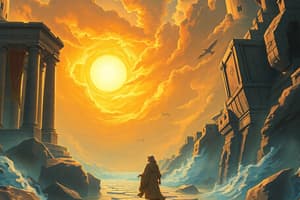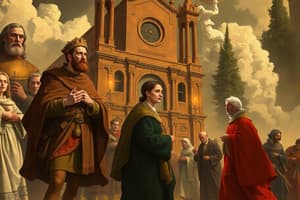Podcast
Questions and Answers
During which art movement did artists focus on the beauty of the natural world and the idealization of the human body?
During which art movement did artists focus on the beauty of the natural world and the idealization of the human body?
- Romanticism
- Renaissance Art (correct)
- Romanesque Art
- Baroque Art
Which art movement was characterized by its dramatic, highly emotional, and energetic style influenced by political and religious turmoil?
Which art movement was characterized by its dramatic, highly emotional, and energetic style influenced by political and religious turmoil?
- Romanesque Art
- Baroque Art (correct)
- Romanticism
- Renaissance Art
Which art movement embraced emotion, intuition, and personal expression, often depicting scenes from everyday life or exploring the beauty of nature?
Which art movement embraced emotion, intuition, and personal expression, often depicting scenes from everyday life or exploring the beauty of nature?
- Romanticism (correct)
- Baroque Art
- Modern Art
- Renaissance Art
Which period saw a revival of classical influences and a new emphasis on realism and perspective?
Which period saw a revival of classical influences and a new emphasis on realism and perspective?
Which period in art history was influenced by technological advancements and led to an explosion of artistic expression?
Which period in art history was influenced by technological advancements and led to an explosion of artistic expression?
Which period saw the emergence of great masters like Leonardo da Vinci, Michelangelo, and Raphael?
Which period saw the emergence of great masters like Leonardo da Vinci, Michelangelo, and Raphael?
What art movement emerged in the 1920s and was influenced by modernity and optimism, featuring sleek lines and geometric shapes?
What art movement emerged in the 1920s and was influenced by modernity and optimism, featuring sleek lines and geometric shapes?
Which art movement aimed to explore the unconscious mind and the irrational, often using dreamlike imagery and juxtaposing unrelated elements?
Which art movement aimed to explore the unconscious mind and the irrational, often using dreamlike imagery and juxtaposing unrelated elements?
Which period in art history was characterized by its use of naturalism, vibrant colors, and intricate detailing?
Which period in art history was characterized by its use of naturalism, vibrant colors, and intricate detailing?
In which art movement did artists focus on capturing the transient effects of light and color in everyday scenes?
In which art movement did artists focus on capturing the transient effects of light and color in everyday scenes?
During which period was art often religious and influenced by the Christian church?
During which period was art often religious and influenced by the Christian church?
Which art movement was characterized by its dramatic, highly emotional, and energetic style influenced by political and religious turmoil?
Which art movement was characterized by its dramatic, highly emotional, and energetic style influenced by political and religious turmoil?
Which period in art history was influenced by technological advancements and led to an explosion of artistic expression?
Which period in art history was influenced by technological advancements and led to an explosion of artistic expression?
During which art movement did artists focus on the beauty of the natural world and the idealization of the human body?
During which art movement did artists focus on the beauty of the natural world and the idealization of the human body?
Which period saw a revival of classical influences and a new emphasis on realism and perspective?
Which period saw a revival of classical influences and a new emphasis on realism and perspective?
Flashcards are hidden until you start studying
Study Notes
Evolution of Art Through History
The evolution of art throughout history can be divided into several phases, each influenced by different historical events, cultural shifts, and technological advancements. As humans developed new tools and techniques, they were able to create increasingly sophisticated works of art, reflecting their experiences, beliefs, and values.
Prehistoric Art
The earliest known forms of art date back to the Upper Paleolithic period, around 40,000 to 10,000 years ago. Cave paintings, rock engravings, and various types of jewelry and ornaments were created during this time. These early works were primarily focused on depicting the natural world, such as animals, landscapes, and human figures.
Ancient Art
As humans began to settle and form societies, art began to reflect the social and political structures of the time. In ancient civilizations like the Egyptians, Greeks, and Romans, art was often used to celebrate the power and glory of the ruling class. monumental sculptures, architectural decorations, and lavish tomb paintings were created to commemorate important figures and events.
Medieval Art
During the Middle Ages, art was heavily influenced by the Christian church. Religious themes, such as the life of Jesus, the apostles, and the saints, were common in painting, sculpture, and architecture. Artists often used a combination of Romanesque and Gothic styles, which were characterized by bold, expressive lines and a focus on light and color.
Renaissance Art
The Renaissance period (1400-1600) marked a significant shift in art, as artists began to focus on the beauty of the natural world and the idealization of the human body. This movement, known as the Renaissance, saw a resurgence of classical influences and a new emphasis on realism and perspective. Some of the most famous artists of this period include Leonardo da Vinci, Michelangelo, and Raphael.
Baroque Art
The Baroque period (1600-1800) was characterized by its dramatic, highly emotional, and energetic style. Artists during this time often used bold colors, intricate Baroque curves, and dramatic lighting to create a sense of movement and excitement. This movement was influenced by the political and religious turmoil of the time, as artists sought to convey the passion and intensity of their subjects.
Romanticism
The Romantic movement (1800-1850) was a reaction against the strict rules and conventions of the Baroque and Neoclassical periods. Romantic artists, such as Vincent van Gogh and Edvard Munch, embraced emotion, intuition, and personal expression, often depicting scenes from everyday life or exploring the beauty of nature.
Modern Art
In the 20th century, art entered a period of great diversity and experimentation. As technology advanced and societies became more interconnected, artists began to explore new forms of expression, such as abstract art, Pop art, and conceptual art. These movements often challenged traditional notions of beauty and artistic technique, focusing instead on the process of creating art and the artist's personal experiences.
Impact of Historical Events on Art
Throughout history, major events have had a significant impact on the development of art. For example, the rise of Christianity and the construction of the Roman Empire both influenced the creation of monumental art in ancient civilizations. The Renaissance period saw a revival of classical influences, while the Baroque period was shaped by the political and religious turmoil of the time.
In more recent history, the rise of modern democracies and technological advancements have led to an explosion of artistic expression, with artists exploring a wide range of styles and techniques to convey their ideas and emotions. These historical events have shaped the evolution of art, as artists respond to the world around them and create new forms of artistic expression.
Art Movements and Historical Context
Art movements are groups of artists who share common artistic goals and styles. Throughout history, various art movements have emerged, each influenced by the historical context in which they were created. Some of the most famous art movements include:
- Impressionism: This 19th-century movement, led by artists like Monet and Degas, focused on capturing the fleeting effects of light and color in everyday scenes.
- Cubism: Pioneered by artists like Pablo Picasso and Georges Braque, Cubism broke down objects into geometric shapes, reassembling them in a fragmented, abstract manner.
- Surrealism: This movement, led by artists like Salvador Dalí and Frida Kahlo, combined elements of reality with fantastical, dream-like elements, often exploring the unconscious mind and the nature of identity.
Each art movement has its own unique characteristics and roots, but they all share a common goal: to challenge traditional notions of art and explore new forms of artistic expression. As history continues to unfold, new art movements will undoubtedly emerge, influenced by the cultural, social, and political contexts of their time.
Studying That Suits You
Use AI to generate personalized quizzes and flashcards to suit your learning preferences.




